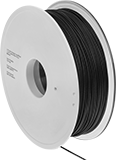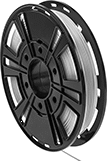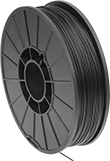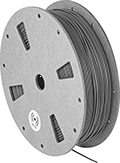Easy-to-Print PLA 3D Printer Filaments

The most commonly used 3D printing material, these PLA filaments make detailed parts at a low melting point, so they won’t warp as they cool, rarely clog nozzles, and don’t require a heated printer bed. They’re also unlikely to drip and produce plastic strings for a clean finished part. In general, they’re best for printing prototypes instead of load-bearing parts since they’re not as strong as ABS or as heat resistant as PEEK. Print them on a fused filament fabrication (FFF) 3D printer.
Carbon fiber-filled PLA filaments make rigid parts that are difficult to bend and break. Their parts can also be threaded and machined more easily than the same non-filled filaments. Because these filaments are abrasive, you should only use them with abrasion-resistant nozzles.
Stainless steel-, iron-, copper-, and brass-filled PLA filaments are heavier and transfer heat better than plastic-only filaments. Brush, sand, or polish printed parts for a metallic finish. Stainless steel and iron are abrasive, so use them with abrasion-resistant nozzles only. Iron will also rust if exposed to water.
Static-dissipative PLA filaments make parts that protect equipment from electrostatic shocks by diverting electrostatic discharges in a controlled way. They’re often used to create tool handles, tote trays, enclosures, and other parts that are used near sensitive electronics. To adjust the surface resistivity of your printed part, change the temperature of your printer’s extruder. As the extruder’s temperature increases, the printed part’s resistivity will decrease.
Conductive PLA filaments are best for creating circuit prototypes and other conductive pathways. To adjust the surface resistivity of your printed part, change the temperature of your printer’s extruder. As the extruder’s temperature increases, the printed part’s resistivity will decrease.
Filaments with an annealing temperature can be heat treated to make parts harder, stronger, and better at resisting heat. To anneal, heat your finished part to the listed temperature and then let it cool slowly.
Tensile strength is the best measure of a filament’s overall strength. Similar to the stress applied on a rope during a game of tug-of-war, it’s the amount of pulling force a material can handle before breaking. A higher rating means a stronger filament. A tensile strength of 5,000 psi and above is considered good; 12,000 psi and above is excellent.
Maximum exposure temperature is the point at which a printed part will begin to deform. Above this temperature, your part will start to lose structural integrity. Filaments that can be annealed are also rated for maximum temperature after annealing, which is the new maximum exposure temperature once that process completes.
Spool | ||||||||||||
|---|---|---|---|---|---|---|---|---|---|---|---|---|
| Dia., mm | Printing Temp. | For Printer Bed Temp. | Tensile Strength | Max. Exposure Temp. | Annealing Temp. | Max. Temp. After Annealing | For Min. Nozzle Dia., mm | Dia., mm | Dp., mm | Wt., g | Each | |
PLA Plastic | ||||||||||||
Clear | ||||||||||||
| 1.75 | 195° to 225° C 383° to 437° F | 21° to 60° C 70° to 140° F | Not Rated | 60° C 140° F | 100° to 120° C 212° to 248° F | 155° C 311° F | 0.4 | 200 | 50 | 500 | 0000000 | 000000 |
| 2.85 | 195° to 225° C 383° to 437° F | 21° to 60° C 70° to 140° F | Not Rated | 60° C 140° F | 100° to 120° C 212° to 248° F | 155° C 311° F | 0.4 | 200 | 50 | 500 | 0000000 | 00000 |
Semi-Clear Gray | ||||||||||||
| 1.75 | 195° to 225° C 383° to 437° F | 21° to 60° C 70° to 140° F | Not Rated | 60° C 140° F | 100° to 120° C 212° to 248° F | 155° C 311° F | 0.4 | 200 | 50 | 500 | 0000000 | 00000 |
| 2.85 | 195° to 225° C 383° to 437° F | 21° to 60° C 70° to 140° F | Not Rated | 60° C 140° F | 100° to 120° C 212° to 248° F | 155° C 311° F | 0.4 | 200 | 50 | 500 | 0000000 | 00000 |
Carbon-Fiber-Filled PLA Plastic | ||||||||||||
Opaque Black | ||||||||||||
| 1.75 | 195° to 225° C 383° to 437° F | 21° to 60° C 70° to 140° F | Not Rated | 60° C 140° F | 100° to 120° C 212° to 248° F | 138° C 280° F | 0.4 | 200 | 50 | 500 | 0000000 | 00000 |
| 1.75 | 195° to 225° C 383° to 437° F | 21° to 60° C 70° to 140° F | Not Rated | 60° C 140° F | 100° to 120° C 212° to 248° F | 138° C 280° F | 0.4 | 300 | 100 | 3,000 | 0000000 | 000000 |
| 1.75 | 210° to 230° C 410° to 446° F | 21° to 60° C 70° to 140° F | Not Rated | 60° C 140° F | __ | __ | 0.4 | 200 | 50 | 500 | 0000000 | 00000 |
| 1.75 | 210° to 230° C 410° to 446° F | 21° to 60° C 70° to 140° F | Not Rated | 60° C 140° F | __ | __ | 0.4 | 300 | 100 | 3,000 | 0000000 | 000000 |
| 2.85 | 195° to 225° C 383° to 437° F | 21° to 60° C 70° to 140° F | Not Rated | 60° C 140° F | 100° to 120° C 212° to 248° F | 138° C 280° F | 0.4 | 200 | 50 | 500 | 0000000 | 00000 |
| 2.85 | 195° to 225° C 383° to 437° F | 21° to 60° C 70° to 140° F | Not Rated | 60° C 140° F | 100° to 120° C 212° to 248° F | 138° C 280° F | 0.4 | 300 | 100 | 3,000 | 0000000 | 000000 |
| 2.85 | 210° to 230° C 410° to 446° F | 21° to 60° C 70° to 140° F | Not Rated | 60° C 140° F | __ | __ | 0.4 | 200 | 50 | 500 | 0000000 | 00000 |
| 2.85 | 210° to 230° C 410° to 446° F | 21° to 60° C 70° to 140° F | Not Rated | 60° C 140° F | __ | __ | 0.4 | 300 | 100 | 3,000 | 0000000 | 000000 |
Stainless Steel-Filled PLA Plastic | ||||||||||||
Opaque Gray | ||||||||||||
| 1.75 | 210° to 230° C 410° to 446° F | 21° to 60° C 70° to 140° F | Not Rated | 60° C 140° F | __ | __ | 0.4 | 200 | 50 | 500 | 0000000 | 00000 |
| 1.75 | 210° to 230° C 410° to 446° F | 21° to 60° C 70° to 140° F | Not Rated | 60° C 140° F | __ | __ | 0.4 | 300 | 100 | 2,000 | 0000000 | 000000 |
| 2.85 | 210° to 230° C 410° to 446° F | 21° to 60° C 70° to 140° F | Not Rated | 60° C 140° F | __ | __ | 0.4 | 200 | 50 | 500 | 0000000 | 00000 |
| 2.85 | 210° to 230° C 410° to 446° F | 21° to 60° C 70° to 140° F | Not Rated | 60° C 140° F | __ | __ | 0.4 | 300 | 100 | 2,000 | 0000000 | 000000 |
Iron-Filled PLA Plastic | ||||||||||||
Opaque Gray | ||||||||||||
| 1.75 | 190° to 210° C 374° to 410° F | 21° to 60° C 70° to 140° F | Not Rated | 60° C 140° F | __ | __ | 0.4 | 200 | 50 | 500 | 0000000 | 00000 |
| 1.75 | 190° to 210° C 374° to 410° F | 21° to 60° C 70° to 140° F | Not Rated | 60° C 140° F | __ | __ | 0.4 | 300 | 100 | 2,000 | 0000000 | 000000 |
| 2.85 | 190° to 210° C 374° to 410° F | 21° to 60° C 70° to 140° F | Not Rated | 60° C 140° F | __ | __ | 0.4 | 200 | 50 | 500 | 0000000 | 00000 |
Copper-Filled PLA Plastic | ||||||||||||
Opaque Bronze | ||||||||||||
| 1.75 | 185° to 215° C 365° to 419° F | 21° to 60° C 70° to 140° F | Not Rated | 60° C 140° F | 100° to 120° C 212° to 248° F | 155° C 311° F | 0.4 | 200 | 65 | 500 | 0000000 | 00000 |
Brass-Filled PLA Plastic | ||||||||||||
Opaque Gold | ||||||||||||
| 1.75 | 185° to 215° C 365° to 419° F | 21° to 60° C 70° to 140° F | Not Rated | 60° C 140° F | 100° to 120° C 212° to 248° F | 155° C 311° F | 0.4 | 200 | 65 | 500 | 0000000 | 00000 |
Static-Dissipative PLA Plastic | ||||||||||||
Opaque Black | ||||||||||||
| 1.75 | 210° to 220° C 410° to 430° F | 23° to 60° C 73° to 140° F | 7,970 psi (Good) | 55° C 131° F | __ | __ | 0.25 | 200 | 70 | 750 | 0000000 | 000000 |
| 2.85 | 210° to 220° C 410° to 430° F | 23° to 60° C 73° to 140° F | 7,970 psi (Good) | 55° C 131° F | __ | __ | 0.25 | 200 | 70 | 750 | 0000000 | 000000 |
Conductive PLA Plastic | ||||||||||||
Opaque Black | ||||||||||||
| 1.75 | 195° to 225° C 383° to 437° F | 21° to 60° C 70° to 140° F | Not Rated | 60° C 140° F | __ | __ | 0.4 | 200 | 50 | 500 | 0000000 | 00000 |
| 1.75 | 195° to 225° C 383° to 437° F | 21° to 60° C 70° to 140° F | Not Rated | 60° C 140° F | __ | __ | 0.4 | 300 | 100 | 2,000 | 0000000 | 000000 |
| 2.85 | 195° to 225° C 383° to 437° F | 21° to 60° C 70° to 140° F | Not Rated | 60° C 140° F | __ | __ | 0.4 | 200 | 50 | 500 | 0000000 | 00000 |
| 2.85 | 195° to 225° C 383° to 437° F | 21° to 60° C 70° to 140° F | Not Rated | 60° C 140° F | __ | __ | 0.4 | 300 | 100 | 2,000 | 0000000 | 000000 |
Ultra-Strength High-Temperature PAEK 3D Printer Filaments

Parts made from these PAEK filaments, a family of materials that includes PEEK and PEKK, remain strong in high temperatures and hold up to wear from repeated use. They don’t degrade when exposed to most chemicals, so they’re often used to print parts for demanding chemical processing applications. Print these filaments on a fused filament fabrication (FFF) 3D printer. Because of their high melting point, you'll need an all-metal extruder and heated printer bed to reach their minimum printing temperature. Without the heated printer bed, parts will cool too quickly and warp.
Fiberglass-filled PEEK filaments make stronger parts that are less likely to warp and shrink than unfilled PEEK filaments. Since they’re abrasive, you should only use them with an abrasion-resistant nozzle.
Tensile strength is the best measure of a filament's overall strength. Similar to the stress applied on a rope during a game of tug-of-war, it's the amount of pulling force a material can handle before breaking. A higher rating means a stronger filament. A tensile strength of 5,000 psi and above is considered good; 12,000 psi and above is excellent.
Maximum exposure temperature is the point at which a printed part will begin to deform. Above this temperature, your printed parts will start to lose structural integrity.
Annealing is the process of heating prints to a specific annealing temperature and then slowly allowing them to cool. This makes the finished print harder, stronger, and better at resisting heat. Maximum temperature after annealing replaces the maximum exposure temperature once this process has been completed.
Spool | |||||||||||||
|---|---|---|---|---|---|---|---|---|---|---|---|---|---|
| Dia., mm | Printing Temp. | For Printer Bed Temp. | Tensile Strength | Max. Exposure Temp. | Max. Annealing Temp. | Max. Temp. After Annealing | For Min. Nozzle Dia., mm | Dia., mm | Dp., mm | Wt., g | Color | Each | |
PEEK Plastic | |||||||||||||
| 1.75 | 375° to 410° C 707° to 770° F | 130° to 145° C 266° to 293° F | 14,500 psi (Excellent) | 140° C 284° F | 140° C 284° F | 230° C 446° F | 0.4 | 195 | 40 | 500 | Opaque Beige | 0000000 | 0000000 |
Fiberglass-Filled PEEK Plastic | |||||||||||||
| 1.75 | 375° to 410° C 707° to 770° F | 130° to 145° C 266° to 293° F | 13,050 psi (Excellent) | 260° C 500° F | 140° C 284° F | 315° C 599° F | 0.4 | 195 | 40 | 500 | Opaque Beige | 0000000 | 000000 |
Steam-Resistant High-Temperature PSU 3D Printer Filaments

Sterilize your printed parts without them expanding, deforming, or weakening. These PSU filaments resist steam and heat, so you can sterilize parts in an autoclave. They also can be sterilized with ethylene oxide, radiation, plasma, dry heat, and cold sterilization methods. Print these filaments on a fused filament fabrication (FFF) 3D printer. Because of their high melting points, you'll need an all-metal extruder and heated printer bed to reach their minimum printing temperature. Without the heated printer bed, parts will cool too quickly and warp.
Tensile strength is the best measure of a filament’s overall strength. Similar to the stress applied on a rope during a game of tug-of-war, it’s the amount of pulling force a material can handle before breaking. A higher rating means a stronger filament. A tensile strength of 5,000 psi and above is considered good; 12,000 psi and above is excellent.
Maximum exposure temperature is the point at which a printed part will begin to deform. Above this temperature, your part will start to lose structural integrity.
Spool | |||||||||||
|---|---|---|---|---|---|---|---|---|---|---|---|
| Dia., mm | Printing Temp. | For Printer Bed Temp. | Tensile Strength | Max. Exposure Temp. | For Min. Nozzle Dia., mm | Dia., mm | Dp., mm | Wt., g | Color | Each | |
PSU Plastic | |||||||||||
| 1.75 | 350° to 380° C 662° to 716° F | 140° to 160° C 284° to 320° F | 10,730 psi (Good) | 172° C 342° F | 0.4 | 198 | 42 | 500 | Semi-Clear Beige | 0000000 | 000000 |
High-Temperature PEI 3D Printer Filaments
 | |
Often used to make parts that will be used near ovens, engines, and other hot machinery, these PEI filaments remain strong and rigid in temperatures that would soften most plastic. They’re a lightweight alternative to machined metal parts. Print these filaments on a fused filament fabrication (FFF) 3D printer. Because of their high melting points, you'll need an all-metal extruder and heated printer bed to reach their minimum printing temperature. Without the heated printer bed, parts will cool too quickly and warp.
Tensile strength is the best measure of a filament’s overall strength. Similar to the stress applied on a rope during a game of tug-of-war, it’s the amount of pulling force a material can handle before breaking. A higher rating means a stronger filament. A tensile strength of 5,000 psi and above is considered good; 12,000 psi and above is excellent.
Maximum exposure temperature is the point at which a printed part will begin to deform. Above this temperature, your part will start to lose structural integrity.
Spool | |||||||||||
|---|---|---|---|---|---|---|---|---|---|---|---|
| Dia., mm | Printing Temp. | For Printer Bed Temp. | Tensile Strength | Max. Exposure Temp. | For Min. Nozzle Dia., mm | Dia., mm | Dp., mm | Wt., g | Color | Each | |
PEI Plastic | |||||||||||
| 1.75 | 350° to 380° C 662° to 716° F | 140° to 160° C 284° to 320° F | 7,830 psi (Good) | 158° C 316° F | 0.4 | 195 | 40 | 500 | Semi-Clear Beige | 0000000 | 0000000 |
| 1.75 | 370° to 390° C 698° to 734° F | 120° to 160° C 248° to 320° F | 8,120 psi (Good) | 208° C 406° F | 0.4 | 195 | 40 | 500 | Opaque Gold | 0000000 | 000000 |
Flexible TPU 3D Printer Filaments

Stretchy, soft, and sturdy, these filaments make durable parts that resist breakage despite repeated use. Stronger than ABS and PLA filaments, they create long-lasting parts, such as seals, sleeves, and gaskets, as well as components that take on high-impact forces, such as springs and snap-fit parts. These filaments don't require a heated printer bed, and they won't shrink or warp when cooling. Use them with a fused filament fabrication (FFF) 3D printer. In general, these flexible filaments require a slow feed rate so they don't jam. The softer your filament, the slower your feed rate will need to be. Store them in a sealed container with a desiccant, or use a dehumidifying cabinet, since ambient humidity will cause the plastic to degrade and weaken.
Conductive filaments can be used to create circuit prototypes and other conductive pathways. You can adjust the surface resistivity by changing the temperature of your printer's extruder. As the extruder’s temperature increases, the printed part’s resistivity will decrease.
Tensile strength is the best measure of a filament's overall strength. Similar to the stress applied on a rope during a game of tug-of-war, it's the amount of pulling force a material can handle before breaking. A higher rating means a stronger filament. A tensile strength of 5,000 psi and above is considered good; 12,000 psi and above is excellent.
Maximum exposure temperature is the point at which a printed part will begin to deform. Above this temperature, your printed parts will start to lose structural integrity.
Spool | ||||||||||||
|---|---|---|---|---|---|---|---|---|---|---|---|---|
| Dia., mm | Printing Temp. | For Printer Bed Temp. | Tensile Strength | Surface Resistivity | Max. Exposure Temp. | For Min. Nozzle Opening Dia., mm | Dia., mm | Dp., mm | Wt., g | Color | Each | |
Conductive TPU Plastic—Durometer 90A (Medium Soft) | ||||||||||||
| 1.75 | 220° to 230° C 428° to 446° F | 45° C 113° F | 1,700 psi | 1.5 × 103 ohms-cm | Not Rated | 0.4 | 200 | 50 | 1,000 | Opaque Black | 0000000 | 0000000 |
| 2.85 | 220° to 230° C 428° to 446° F | 45° C 113° F | 1,700 psi | 1.5 × 103 ohms-cm | Not Rated | 0.4 | 200 | 50 | 1,000 | Opaque Black | 0000000 | 000000 |
Dremel 3D Printer Filaments

Build parts and prototypes from these filaments using Dremel fused filament fabrication (FFF) 3D printers. An RFID tag on the spool communicates with your printer, automatically adjusting it to the correct temperature and print speed for the filament material and notifying you when the filament is running out.
PLA filaments are the most commonly used in 3D printing. PLA is easy to use; it rarely clogs nozzles, doesn’t require a heated printer bed, and prints at a low temperature—meaning parts won’t warp while cooling. It produces string-free parts, so you can use it to print with a high level of detail. Less durable and more sensitive to heat than ECO-ABS, PLA is better for printing prototypes than end-use parts.
Tensile strength is the best measure of a filament's overall strength. Similar to the stress applied on a rope during a game of tug-of-war, it's the amount of pulling force a material can handle before breaking. A higher rating means a stronger filament. A tensile strength of 5,000 psi and above is considered good; 12,000 psi and above is excellent.
Maximum exposure temperature is the point at which a printed part will begin to deform. Above this temperature, your printed parts will start to lose structural integrity.




























